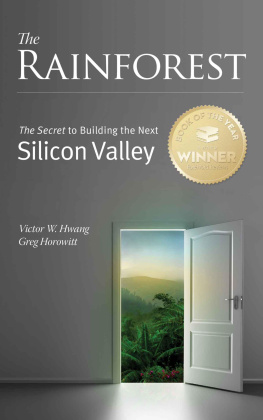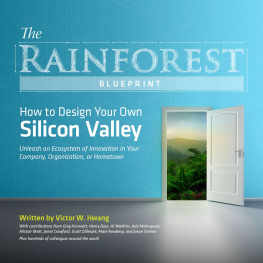Hwang Victor W. - The Rainforest: The Secret to Building the Next Silicon Valley
Here you can read online Hwang Victor W. - The Rainforest: The Secret to Building the Next Silicon Valley full text of the book (entire story) in english for free. Download pdf and epub, get meaning, cover and reviews about this ebook. year: 2012, publisher: Regenwald, genre: Politics. Description of the work, (preface) as well as reviews are available. Best literature library LitArk.com created for fans of good reading and offers a wide selection of genres:
Romance novel
Science fiction
Adventure
Detective
Science
History
Home and family
Prose
Art
Politics
Computer
Non-fiction
Religion
Business
Children
Humor
Choose a favorite category and find really read worthwhile books. Enjoy immersion in the world of imagination, feel the emotions of the characters or learn something new for yourself, make an fascinating discovery.
- Book:The Rainforest: The Secret to Building the Next Silicon Valley
- Author:
- Publisher:Regenwald
- Genre:
- Year:2012
- Rating:4 / 5
- Favourites:Add to favourites
- Your mark:
- 80
- 1
- 2
- 3
- 4
- 5
The Rainforest: The Secret to Building the Next Silicon Valley: summary, description and annotation
We offer to read an annotation, description, summary or preface (depends on what the author of the book "The Rainforest: The Secret to Building the Next Silicon Valley" wrote himself). If you haven't found the necessary information about the book — write in the comments, we will try to find it.
The Rainforest: The Secret to Building the Next Silicon Valley — read online for free the complete book (whole text) full work
Below is the text of the book, divided by pages. System saving the place of the last page read, allows you to conveniently read the book "The Rainforest: The Secret to Building the Next Silicon Valley" online for free, without having to search again every time where you left off. Put a bookmark, and you can go to the page where you finished reading at any time.
Font size:
Interval:
Bookmark:


Table of Contents
Copyright
Copyright 2012 by Victor W. Hwang and Greg Horowitt
All rights reserved. No part of this publication may be reproduced, distributed, or transmitted in any form or by any means, including photocopying, recording, or other electronic or mechanical methods, without the prior written permission of the publisher, except in the case of brief quotations permitted by copyright law. For permission requests, write to the publisher, with subject line Attention: Permissions Coordinator, at info@therainforestbook.com.
Rainforest is a trademark and may not be used without permission.
Published by Regenwald
Los Altos Hills, California, U.S.A.
Cover and book design by Bill Rogers
eBook Conversion by KindleExpert.com
ISBN-13: 978-0615586724 (Paperback)
Library of Congress Control Number: 2012901584
Edition 1.0 (February 21, 2012)
Dedication
For Anders and Augustine, whose generation will inherit the Rainforest.
And on the other hand, if I convey to my men my love for sailing on the seaand each of them is so inclined because of an urge in his heartthen you will soon see them diversify according to their many particular abilities. This one will weave sails. The other will fell a tree with the flash of his axe. The other, still, will forge nails. And there will be someone somewhere who will observe the stars so as to learn how to helm.
However, in the end, all will be one. Creating the ship isnt about weaving the sails, forging the nails, reading the stars, but rather imparting a taste for the sea, which is unifying. And in this light, there is no longer conflict, but in community there is love.
Antoine de Saint-Exupry, Citadelle (1948)
Introduction: Our Journey
We knocked on the door and were ushered into a waiting area. At first glance, there was nothing remarkable about the room. It was a typical office in an emerging city. This one happened to house a national institute charged with leading innovation development for the country. We have been to many of these institutes around the world, and they all look about the same.
But then we saw the wall.
What someone decides to put on a wall is revealing. Walls are aspirational. College students often decorate their walls with admired musicians, sports cars, or celebrities. Large companies often hang inspirational posters or modern art.
When you visit many incubators or venture capital firms in Silicon Valley, you see something unique to that world. You see trophies, but not brass cups or blue ribbons. Instead, the trophies are the names of the successful startup companies the firm helped grow. Often, you will see logos like Google, Amazon, Cisco, and others emblazoned proudlysometimes arrogantlyon the walls of their entrance rooms. That is what we have come to expect.
In this particular office, however, we saw something that struck us as bizarre. Right above the place where visitors sit, clearly for everyone to see, were plaques we had never before seen in such a place:

What was starkly obvious at that moment was how terrible the world is at managing innovation. To date, there has been no systematic way to measure innovation, change it, or grow it. The management tool, ISO 9001, was created in the 1980s as a way to certify quality control for manufacturing processes. Borrowed from a different paradigm, it was definitely the wrong tool for the job.
For all the aspirational talk about innovation by CEOs and Presidents, society still lacks the right tools to deal with innovation. Like ISO 9001, the best management tools available are the same ones that automobile manufacturers might use to calibrate the quality of machine parts. If that is really the best management tool available for innovation, it is no wonder governments and corporations have such a hard time with it!
Why were we sitting in this room? We call this work Extreme Venture Capitalworking on the fringes of the worlds venture economy to fund the growth and development of promising startup companies. This work takes us from places as developed as Japan, Taiwan, Scandinavia, and New Zealand, to still emerging regions such as Mexico, Egypt, Kazakhstan, Colombia, Saudi Arabia, and the Palestinian Territories.
We are atypical venture capitalists. Our practice consists of two interconnected halves. On one side, we do what many venture capitalists dowe identify and invest in highly selective technology startup companies, and try to help them grow quickly and profitably, forming close partnerships with our entrepreneurs. Frequently, we work with scientists who are building companies from scratch based on their university research. Our chosen startups span a range of sectors from software to hardware, from biomedicine to bio-agriculture, from renewable resources to clean water.
On the other side, we take the insights gleaned from our hands-on experience and apply them to global development by working with governments to develop venture funds, startup incubators, and technology policy in emerging markets. We have a rare set of proficiencies at this intersection of private venture and public policy. We have advised dozens of institutions, such as the World Bank, the U.S. Agency for International Development, and numerous foreign governments. We have mentored thousands of entrepreneurs and innovators in over 30 countries. This has given us a special vantage point from which to observe some of the most interesting emerging companies in the world. We have managed organizationsLarta Institute, CONNECT, and Global CONNECTthat are considered thought leaders in this field. Today, we run T2 Venture Capital, which is headquartered in Silicon Valley and has offices in San Diego, North Carolina, Washington, D.C., and Dubai, among other places.
Over decades of combined experience, we have developed a unique field of expertise the analysis and fostering of innovation systems . In so doing, we have discovered that the development of entire innovation systems differs profoundly from the conventional wisdom for encouraging innovation at the scale of individuals or small teams.
A New Theory of Everything
This book is different than what you might expect. This is not actually a book on how to innovate an idea or a product. It is rather a book about the nature of innovation. To be more precise, it is about the nature of complex innovation systemswhether they are in Silicon Valley, a large corporation, or anywhere elseand how we can foster the development of those systems. We believe that society, up to now, has failed to explain how such systems behave.
This gap in knowledge is significant because innovation is increasingly treated like the salvation for the worlds economic future. Hundreds of books, tens of thousands of articles, and probably millions of Tweets have been scribed about how to do innovative actions one idea at a time. Very little has been written about how to cause innovation on a systemic level. Despite enormous public investments globally, only a few regions like Silicon Valley have become enduring innovation ecosystems human networks that generate extraordinary creativity and output on a sustainable basis.
What is the nature of such innovation ecosystems, and how can we deliberately build them? In this book, we propose a radical theory of everything to explain the workings of innovation ecosystems. We call our model for such a system the Rainforest . It is an ambitious undertaking, and we probably dont get everything perfect. But we believe that by weaving together our personal observations with what we know about human nature, evolutionary biology, economic cooperation, and social systems, we can offer a new and more productive way of thinking about innovation. As a result, we can bridge together micro observations and macro theory. This book does not stop at theory: we give you practical tools to enhance innovation.
Next pageFont size:
Interval:
Bookmark:
Similar books «The Rainforest: The Secret to Building the Next Silicon Valley»
Look at similar books to The Rainforest: The Secret to Building the Next Silicon Valley. We have selected literature similar in name and meaning in the hope of providing readers with more options to find new, interesting, not yet read works.
Discussion, reviews of the book The Rainforest: The Secret to Building the Next Silicon Valley and just readers' own opinions. Leave your comments, write what you think about the work, its meaning or the main characters. Specify what exactly you liked and what you didn't like, and why you think so.



